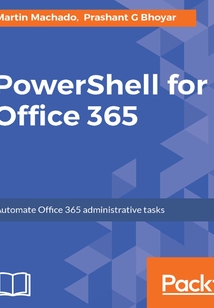目錄(149章)
倒序
- coverpage
- Title Page
- Credits
- About the Authors
- About the Reviewer
- www.PacktPub.com
- Why subscribe?
- Customer Feedback
- Preface
- What this book covers
- What you need for this book
- Who this book is for
- Conventions
- Reader feedback
- Customer support
- Downloading the example code
- Downloading the color images of this book
- Errata
- Piracy
- Questions
- PowerShell Fundamentals
- Why do we need to learn PowerShell for Office 365?
- PowerShell is a cmdlet based language with verb-noun syntax
- How to pass parameters to cmdlets and storing results as a variable
- Parameters
- How to get help with PowerShell
- What is a module?
- What is a pipe?
- How PowerShell is an object-oriented language and how to work with objects
- Using the if and where statements
- Using the for and while loops
- Creating your first script
- Summary
- Managing Office 365 with PowerShell
- Admin roles for Office 365
- Installing and working with the Office 365 admin tools
- Installing Microsoft Online Service Sign-In Assistant
- Installing the Windows Azure Active Directory Module for PowerShell
- Verifying installation of the Office 365 admin tools
- Creating the first user account in PowerShell
- Ensuring user account permissions
- Checking license availability
- Creating a new user
- Summary
- Azure AD and Licensing Management
- Common administrative cmdlets that are used for managing accounts and licensing
- How to change the license for existing users
- Formatting data to be used for bulk account management
- How to reset account passwords
- How to update user account details
- Summary
- Managing SharePoint Online Using PowerShell
- A brief overview of the SharePoint APIs
- The SharePoint web services API
- The SharePoint server-side API and PowerShell API
- The client-side object model
- The REST API
- The SharePoint Online API
- Setting up your environment
- PowerShell execution policy
- SharePoint Online Management Shell
- Security requirements
- SharePoint Online scripting
- Scenario 1 - getting to know the API
- Scenario 2 - site collection information
- Scenario 3 - site collection maintenance
- Testing site health
- Scenario 4 - personal sites
- Scenario 5 - sharing and external access
- Guest access
- Scenario 6 - CSOM scripting using PowerShell
- Environment setup
- Connecting to SharePoint Online via CSOM
- CSOM queries
- Scenario 7 - the REST API in PowerShell
- Summary
- Managing Exchange Online Using PowerShell
- Connecting to Exchange Online
- Exploring the API
- Working with Exchange accounts
- Creating new mailboxes
- Scenario 1 - a new user mailbox
- Scenario 2 - an unlicensed existing user
- Scenario 3 - a licensed user without the Exchange service
- Scenario 4 - MailUser
- User photos
- Email forwarding
- Out-of-office reply
- Inbox rules
- User impersonation
- Installing Exchange Web Services
- Role-based access control
- Management roles
- Role groups
- Management role assignment
- RBAC scenario - creating a custom administrator
- First requirement - limiting access to PowerShell commands
- Second requirement - limiting access to a group of users
- Summary
- Script Automation
- PowerShell modules
- Module manifest
- Script modules
- Cmdlets
- Scheduled execution
- Scripting instrumentation - the next steps
- Code signing
- Setting up a signing infrastructure
- The PKI module
- Self-signed certificates
- Creating a CA certificate
- Querying certificate stores
- Exporting importing and publishing certificates
- Issuing certificates with a self-signed CA
- Active Directory Certificate Services
- Prerequisites
- Requesting and issuing certificates in AD CS
- Signing PowerShell scripts
- IncludeChain
- TimestampServer
- Summary
- Patterns and Practices PowerShell
- Why do we need to learn PnP PowerShell?
- Installing and working with PnP PowerShell cmdlets
- PowerShell Gallery
- Using Setup files/binaries
- Installation script
- Verifying the installation of the PnP PowerShell module for SharePoint Online
- Using Windows Credential Manager with PnP PowerShell
- An example of provisioning site collection using a standard template
- Summary
- OneDrive for Business
- Feature configuration
- Personal site management
- Data migration
- The CSOM API
- The SPO Migration API
- Office 365 Import service
- Creating an Azure Blob storage account
- Migrating data using Azure Blob storage
- Summary
- PowerShell Core
- Installing PowerShell Core
- Remoting on PowerShell Core
- WinRM remote management
- SSH Remote management
- Managing SharePoint with PowerShell Core
- Managing SharePoint Online from PowerShell Core
- Summary 更新時間:2021-07-02 18:51:03
推薦閱讀
- UNIX編程藝術(shù)
- WebAssembly實戰(zhàn)
- 區(qū)塊鏈架構(gòu)與實現(xiàn):Cosmos詳解
- Mastering Articulate Storyline
- 從程序員到架構(gòu)師:大數(shù)據(jù)量、緩存、高并發(fā)、微服務(wù)、多團隊協(xié)同等核心場景實戰(zhàn)
- Mastering KnockoutJS
- Getting Started with Python and Raspberry Pi
- Buildbox 2.x Game Development
- 零基礎(chǔ)輕松學C++:青少年趣味編程(全彩版)
- Monitoring Docker
- Moodle 3.x Developer's Guide
- Spring Boot 2+Thymeleaf企業(yè)應(yīng)用實戰(zhàn)
- SAP HANA Starter
- Unity Certified Programmer:Exam Guide
- 深入理解C++11:C++11新特性解析與應(yīng)用
- ASP.NET開發(fā)技巧精講
- 區(qū)塊鏈技術(shù)與智能服務(wù)應(yīng)用
- 競技游戲設(shè)計實戰(zhàn)指南:MOBA+RTS+TCG+FPS
- Python深度學習實戰(zhàn):基于TensorFlow和Keras的聊天機器人以及人臉、物體和語音識別
- 零基礎(chǔ)學Visual Basic第2版
- OpenCV計算機視覺項目實戰(zhàn)(Python版)
- Go語言高級編程
- Learning IPython for Interactive Computing and Data Visualization
- 碼農(nóng)修行:編寫優(yōu)雅代碼的32條法則
- Java EE企業(yè)級應(yīng)用開發(fā)技術(shù)研究
- Python基礎(chǔ)實例教程(微課版)
- 孩子趣味學編程之Scratch篇
- 大學計算機基礎(chǔ)
- 高性能響應(yīng)式Web開發(fā)實戰(zhàn)
- Web Development with Django Cookbook(Second Edition)


